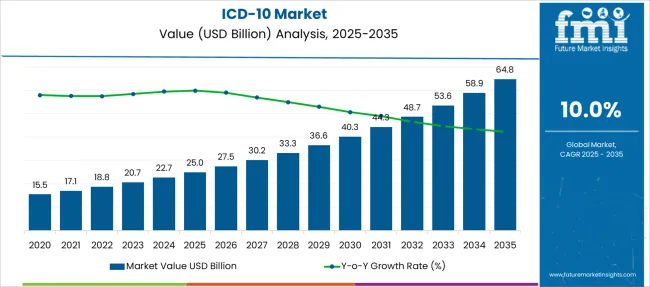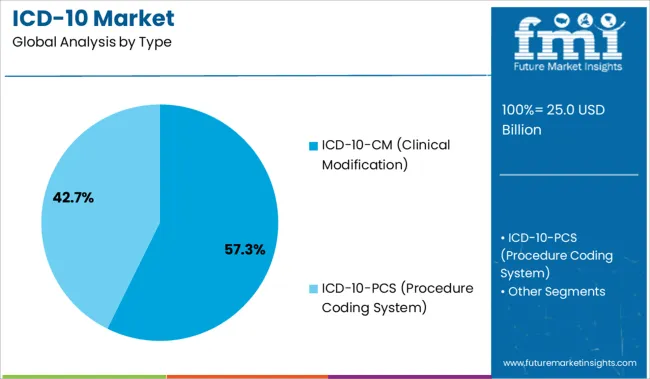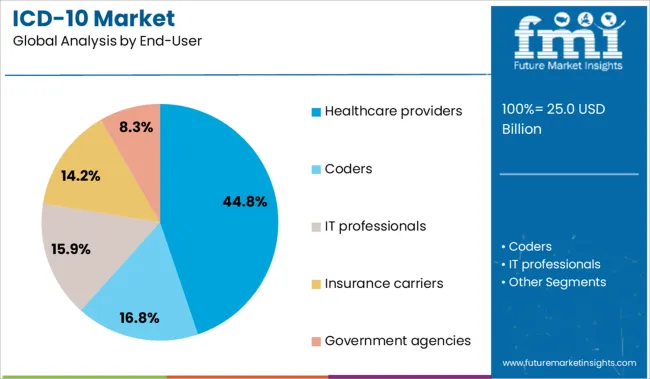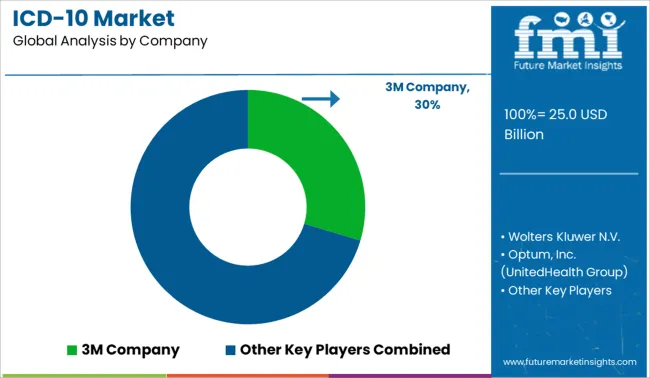The ICD-10 Market is estimated to be valued at USD 25.0 billion in 2025 and is projected to reach USD 64.8 billion by 2035, registering a compound annual growth rate (CAGR) of 10.0% over the forecast period.

| Metric | Value |
|---|---|
| ICD-10 Market Estimated Value in (2025 E) | USD 25.0 billion |
| ICD-10 Market Forecast Value in (2035 F) | USD 64.8 billion |
| Forecast CAGR (2025 to 2035) | 10.0% |
The ICD 10 market is witnessing accelerated growth due to the global shift toward standardized healthcare data, improved patient care delivery, and heightened regulatory compliance needs. As electronic health records become central to clinical workflows, the integration of detailed and structured coding systems like ICD 10 is enhancing the accuracy of diagnosis documentation, billing, and analytics.
Payers and regulators are increasingly requiring specificity in coding to reduce fraud, enable population health monitoring, and streamline reimbursements. Continued investments in healthcare IT infrastructure and ongoing training initiatives are further supporting adoption.
The future outlook remains strong as stakeholders recognize the role of precise medical classification in driving operational efficiency, clinical transparency, and value based care outcomes across healthcare ecosystems.
The market is segmented by Type and End-User and region. By Type, the market is divided into ICD-10-CM (Clinical Modification) and ICD-10-PCS (Procedure Coding System). In terms of End-User, the market is classified into Healthcare providers, Coders, IT professionals, Insurance carriers, and Government agencies. Regionally, the market is classified into North America, Latin America, Western Europe, Eastern Europe, Balkan & Baltic Countries, Russia & Belarus, Central Asia, East Asia, South Asia & Pacific, and the Middle East & Africa.

The ICD 10 CM segment is projected to represent 57.30% of total market revenue by 2025 within the type category, making it the most widely adopted format. This growth is attributed to its granular classification system tailored for clinical modification, allowing healthcare providers to record diagnoses with greater precision.
It supports effective patient data documentation, enhances clinical reporting accuracy, and facilitates optimized coding for reimbursement purposes. As medical practices and hospitals transition to data driven care delivery models, the demand for detailed diagnostic classification has intensified.
ICD 10 CM has become central to improving claim accuracy, supporting clinical audits, and advancing quality measurement programs, reinforcing its dominant position in the market.

Healthcare providers are anticipated to contribute 44.80% of total market revenue by 2025 in the end user category, emerging as the largest user base. This is driven by the growing need for accurate coding in clinical documentation, treatment planning, and reimbursement processes.
Hospitals, outpatient clinics, and physician groups have increasingly integrated ICD 10 systems into their electronic medical records to support regulatory compliance and quality reporting mandates. Furthermore, the complexity of modern care delivery and chronic disease management requires detailed coding to ensure proper care coordination and financial sustainability.
As a result, healthcare providers continue to lead adoption, leveraging ICD 10 to enhance clinical accuracy, streamline workflows, and meet the evolving standards of healthcare governance.
The need for quality measurement and medical error reduction for patient safety led to the improvement of ICD-9 and the creation of ICD-10. ICD-10-CM has 69,000 diagnosis codes compared to ICD-9-CM's 14,000 codes. This more correctly represents the problem's specificity.
ICD-10 also has a greater number of combination codes than ICD-9, which had a limited number of combination codes. This boosts the ICD-10 market adoption trends.
Second, the need for a large amount of medical data for clinical research drives demand for ICD-10. With all of the information in one place, it is much easier to retrieve data for clinical study.
Rising insurance fraud and insurance concerns related to misinterpretation of medical papers are also driving demand for ICD-10, particularly in developed countries.
Frequent categorization system revisions, combined with increased use of coding and billing methods in hospital revenue cycle management, are likely to create considerable ICD-10 market growth potential during the forecast period.
However, the deployment of ICD-10 by healthcare professionals across the country proved to be quite costly, which results in restraining the ICD-10 market growth. This is due to the fact that each healthcare provider, together with other organisations in the chain, employs at least 100 physicians. As a result, adopting it throughout the chain becomes prohibitively expensive for providers.
North America dominated the ICD-10 market, accounting for the greatest revenue share. The high adoption rate of sophisticated healthcare solutions in everyday hospital operations, as well as the availability of a large number of medical coding solution providers, is projected to contribute to the region's dominance throughout the forecast period.
Increasing awareness of the availability of advanced hospital solutions, increased penetration of private healthcare insurance companies, and an increase in the number of medical coding outsourcing companies in Asia Pacific are some of the key factors expected to drive profitable regional growth of the market for ICD-10.
Furthermore, the Asia Pacific market for ICD-10 is likely to benefit from factors such as improving healthcare facilities and booming medical tourism in countries such as China, India, Malaysia, and Thailand.

ICD-10 codes are developed and published solely by the World Health Organization (WHO), and the system is used by government agencies and other governing authorities.
Client involvement through long-term contracts, as well as developing regional presence, is some of the primary techniques employed by these leaders in the market for ICD-10 to gain a competitive advantage.
Recent Occurrences
Innoventrum and Dental Medical Billing formed cooperation in January 2024 to develop a superior credentialing programme for dental-to-medical cross-coding and billing. Candidates in the programme can obtain designations in nine disciplines, including dental implant coding, sleep apnea, oral surgery, sedation dentistry, and CBCT coding and reimbursement.
Need for quality measurement and medical error reduction for the safety of patients led to the improvisation of ICD-9 and creation of ICD-10. ICD-10-CM contains 69,000 diagnosis codes as compared to 14,000 codes of ICD-9-CM. This captures the specificity of the problem more accurately.
ICD-10 also provides a large number of combination codes in comparison to ICD-9 which had limited combination codes.
Secondly, need for a large amount of medical data for the purpose of clinical research also drives the demand for ICD-10. With the availability of all the information at one place, it becomes easy to extract information for clinical research.
However, the implementation of ICD-10 across the country by healthcare providers proves to be very costly. This is because each healthcare provider has a minimum of 100 physicians under it along with other entities in the chain. Therefore, implementing it across the chain becomes very expensive for the providers.
The World Health Organization (WHO) is the sole developer and publisher of ICD-10 codes, while the system is adopted by government agencies and other regulating bodies.
The report is a compilation of first-hand information,qualitative and quantitative assessment by industry analysts, inputs from industry experts and industry participants across the value chain.
The report provides in-depth analysis of parent market trends,macro-economic indicators and governing factors along with market attractiveness as per segments. The report also maps the qualitative impact of various market factors on market segments.
The global icd-10 market is estimated to be valued at USD 25.0 billion in 2025.
The market size for the icd-10 market is projected to reach USD 64.8 billion by 2035.
The icd-10 market is expected to grow at a 10.0% CAGR between 2025 and 2035.
The key product types in icd-10 market are icd-10-cm (clinical modification) and icd-10-pcs (procedure coding system).
In terms of end-user, healthcare providers segment to command 44.8% share in the icd-10 market in 2025.






Our Research Products

The "Full Research Suite" delivers actionable market intel, deep dives on markets or technologies, so clients act faster, cut risk, and unlock growth.

The Leaderboard benchmarks and ranks top vendors, classifying them as Established Leaders, Leading Challengers, or Disruptors & Challengers.

Locates where complements amplify value and substitutes erode it, forecasting net impact by horizon

We deliver granular, decision-grade intel: market sizing, 5-year forecasts, pricing, adoption, usage, revenue, and operational KPIs—plus competitor tracking, regulation, and value chains—across 60 countries broadly.

Spot the shifts before they hit your P&L. We track inflection points, adoption curves, pricing moves, and ecosystem plays to show where demand is heading, why it is changing, and what to do next across high-growth markets and disruptive tech

Real-time reads of user behavior. We track shifting priorities, perceptions of today’s and next-gen services, and provider experience, then pace how fast tech moves from trial to adoption, blending buyer, consumer, and channel inputs with social signals (#WhySwitch, #UX).

Partner with our analyst team to build a custom report designed around your business priorities. From analysing market trends to assessing competitors or crafting bespoke datasets, we tailor insights to your needs.
Supplier Intelligence
Discovery & Profiling
Capacity & Footprint
Performance & Risk
Compliance & Governance
Commercial Readiness
Who Supplies Whom
Scorecards & Shortlists
Playbooks & Docs
Category Intelligence
Definition & Scope
Demand & Use Cases
Cost Drivers
Market Structure
Supply Chain Map
Trade & Policy
Operating Norms
Deliverables
Buyer Intelligence
Account Basics
Spend & Scope
Procurement Model
Vendor Requirements
Terms & Policies
Entry Strategy
Pain Points & Triggers
Outputs
Pricing Analysis
Benchmarks
Trends
Should-Cost
Indexation
Landed Cost
Commercial Terms
Deliverables
Brand Analysis
Positioning & Value Prop
Share & Presence
Customer Evidence
Go-to-Market
Digital & Reputation
Compliance & Trust
KPIs & Gaps
Outputs
Full Research Suite comprises of:
Market outlook & trends analysis
Interviews & case studies
Strategic recommendations
Vendor profiles & capabilities analysis
5-year forecasts
8 regions and 60+ country-level data splits
Market segment data splits
12 months of continuous data updates
DELIVERED AS:
PDF EXCEL ONLINE

Thank you!
You will receive an email from our Business Development Manager. Please be sure to check your SPAM/JUNK folder too.
Chat With
MaRIA